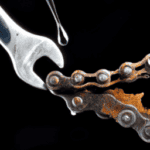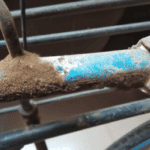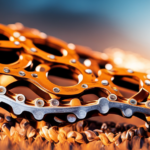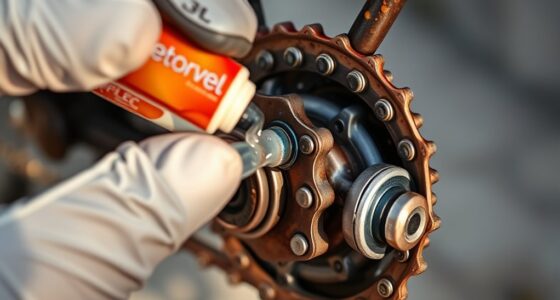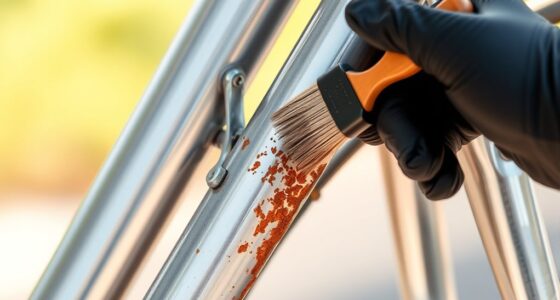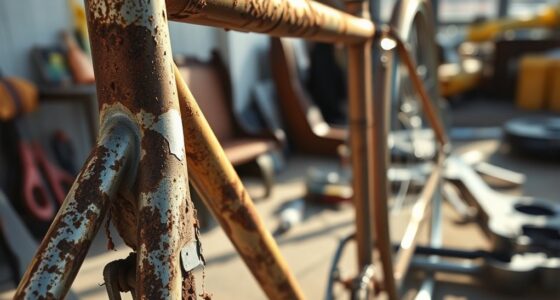To remove surface rust from frames, start by wearing protective gear and ensuring your workspace is well-ventilated. Use a wire brush or steel wool to scrub away loose rust and dirt, then consider a power drill with a wire brush attachment for stubborn spots. After cleaning, apply a rust converter or neutralizer to stop ongoing corrosion, followed by a primer and a rust-resistant topcoat. For best results, learn more about effective rust removal techniques to protect your frame long-term.
Key Takeaways
- Inspect affected areas to assess rust severity and determine if professional treatment is needed.
- Wear protective gear and prepare a clean workspace before removing rust.
- Use wire brushes, steel wool, or a power drill with wire brush attachment to scrub loose rust thoroughly.
- Apply a rust converter or neutralizer to chemically stop rust progression.
- Finish with primer and rust-resistant paint to protect the surface and prevent future corrosion.
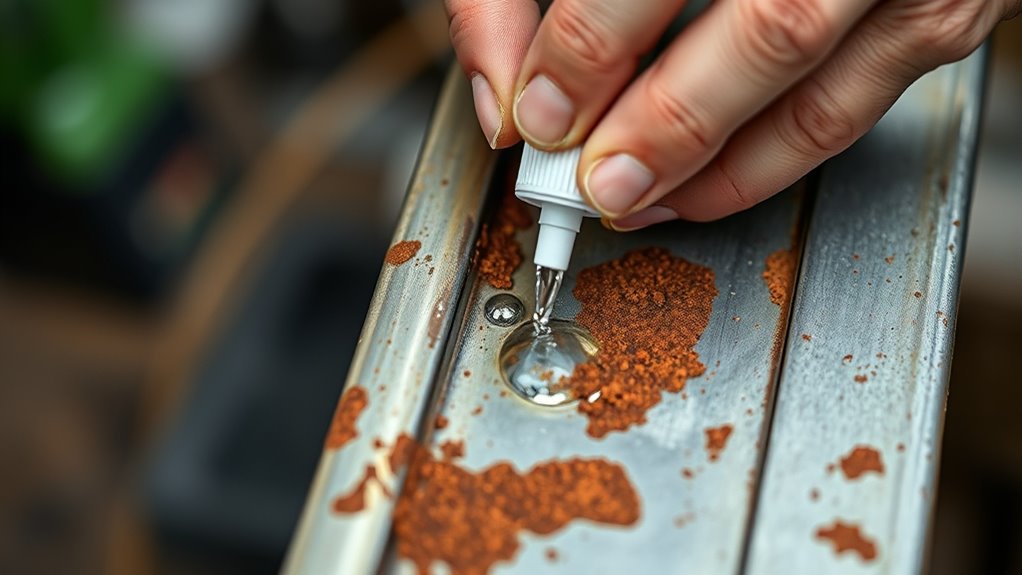
If your vehicle or equipment has developed surface rust on its frames, addressing it promptly can prevent further corrosion and structural damage. Rust might seem minor at first, but if left unchecked, it can compromise the integrity of the entire frame. The key to effective rust removal is combining immediate action with proper techniques to ensure long-term rust prevention and maintain the frame’s strength. Regular frame maintenance is essential in extending the lifespan of your vehicle or equipment, especially if you operate in harsh environments or areas prone to moisture.
Promptly treat surface rust to prevent structural damage and extend your vehicle’s lifespan.
Start by inspecting the affected areas carefully. You want to identify all rust spots and determine how deep the corrosion has penetrated. Light surface rust can often be removed with basic tools and methods, but more severe corrosion might require specialized products or professional intervention. Once you’ve assessed the damage, prepare your workspace. Wear protective gear like gloves and safety glasses to shield yourself from dust, debris, and chemical fumes. Proper ventilation is also important if you’re working indoors.
The first step in removing surface rust is to clean the area thoroughly. Use a wire brush or steel wool to scrub away loose rust and dirt. For stubborn spots, a power drill with a wire brush attachment can save you time and effort. This process not only clears the surface but also roughens it slightly, which helps the following rust prevention steps to bond better. After brushing, wipe down the area with a clean cloth dampened with a degreaser or mild cleaner to remove grease, oil, and leftover debris.
Once the surface is clean and dry, apply a rust converter or rust neutralizer. These products chemically convert rust into a stable compound, stopping further corrosion. Follow the manufacturer’s instructions carefully—most require a specific drying time before proceeding. After applying the converter, consider using a primer designed for metal surfaces. Primers create a protective barrier that inhibits future rust formation and provides a solid base for paint or other protective coatings.
Finally, finish with a durable topcoat, like enamel paint or a rust-resistant coating. This adds an extra layer of protection, preventing moisture and oxygen from reaching the metal. Remember, regular frame maintenance involves inspecting your vehicle or equipment periodically, especially after exposure to moisture or salt. Promptly addressing surface rust not only preserves the appearance but also preserves the structural integrity of your frame, saving you money and hassle in the long run. Proper rust prevention techniques make all the difference in keeping your vehicle or equipment in top condition for years to come. Incorporating proper protective coatings can significantly enhance the longevity of your repairs.
Frequently Asked Questions
Can I Prevent Rust From Returning After Removal?
Yes, you can prevent rust from returning after removal by applying rust-resistant coatings. To keep rust at bay, make certain you thoroughly clean and dry the surface first. Then, use a high-quality primer and paint designed for metal. Regularly inspect and touch up any chipped or scratched areas. Preventing rust involves ongoing maintenance and protective coatings that create a barrier against moisture and oxygen, which cause rust to form again.
What Tools Are Best for Removing Surface Rust?
Think of removing surface rust like peeling paint—you need the right tools to get beneath the surface. A wire brush is your best bet for scrubbing off loose rust, while a rust converter can treat stubborn spots and stop further corrosion. For delicate areas, a drill with a wire wheel attachment works wonders. Combining these tools guarantees a thorough clean, helping your frame stay rust-free longer.
How Long Does the Rust Removal Process Typically Take?
The rust removal process usually takes between a few hours to a day, depending on rust severity. You should start with sanding techniques to remove loose rust and then apply a rust converter to treat remaining areas. Make certain to work thoroughly and allow the converter to cure as directed. This approach ensures the surface is clean, protected, and ready for painting or finishing.
Is It Safe to Use Chemical Rust Removers Indoors?
Think of chemical rust removers as a storm passing through your space; indoors, it’s safest only if you have good indoor ventilation. You should absolutely avoid using them in poorly ventilated areas because chemical fumes can linger and harm your health. Always guarantee proper airflow, like opening windows and using fans, to keep yourself safe. If unsure, consider alternative methods to protect your home and yourself from harmful fumes.
Can Surface Rust Be Removed Without Damaging the Frame Paint?
Yes, you can remove surface rust without damaging the frame paint by using rust converters and rust proofing products. Apply rust converters directly to the rusted areas, as they chemically neutralize rust and create a protective layer. Be careful to follow the instructions and avoid excessive scrubbing, which can damage the paint. After treatment, consider applying a fresh coat of paint or rust proofing to prevent future corrosion.
Conclusion
As you finish removing the rust, imagine the sun catching the freshly cleaned frame, its shine revealing a new beginning. Sometimes, a simple scrub transforms not just metal but your perspective, turning rough patches into smooth surfaces. You might find yourself surprised how a little effort can restore both the frame and your confidence. With each stroke, you’re not just cleaning rust—you’re bringing back strength and brightness, making the frame feel almost new again, ready to face whatever’s ahead.



